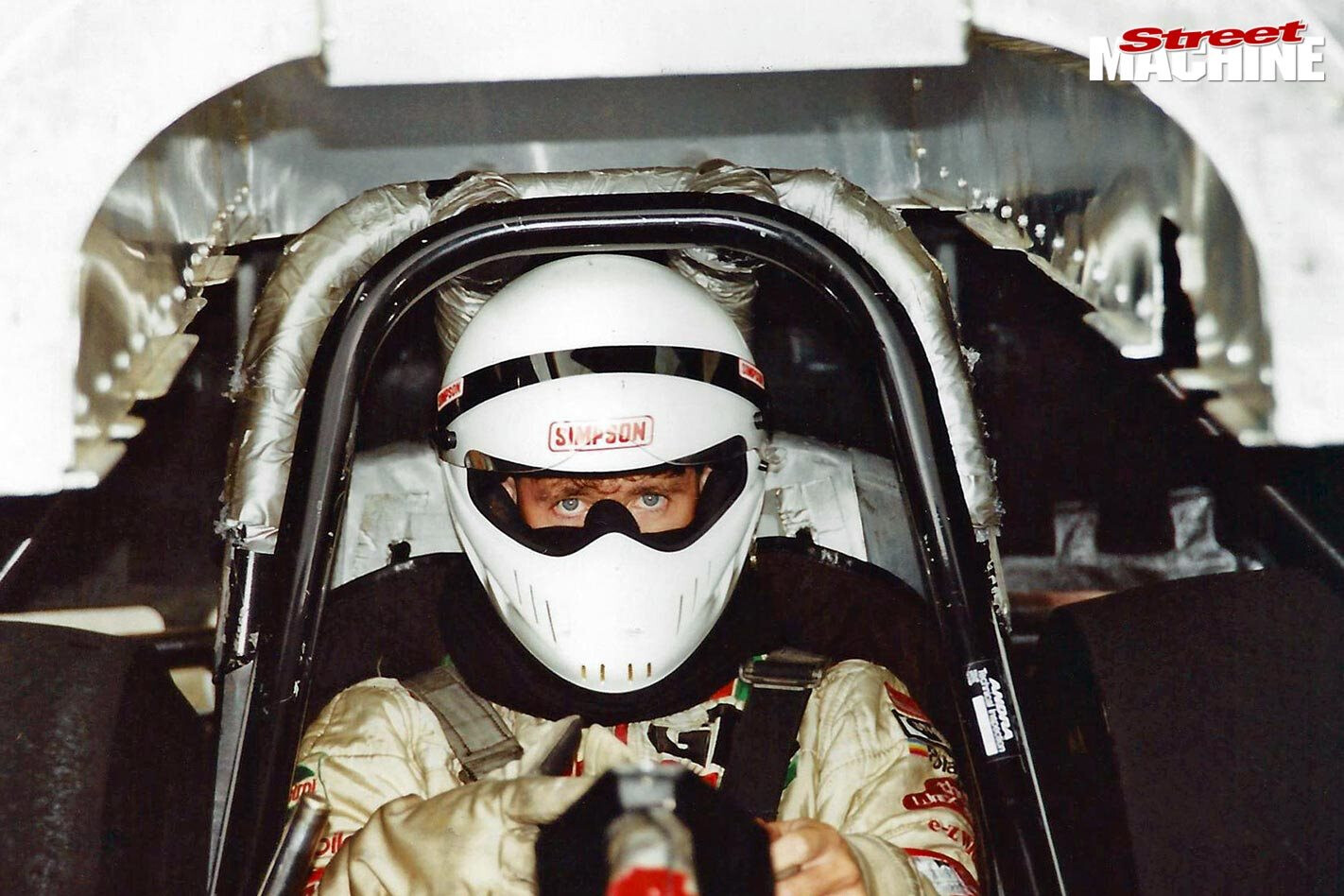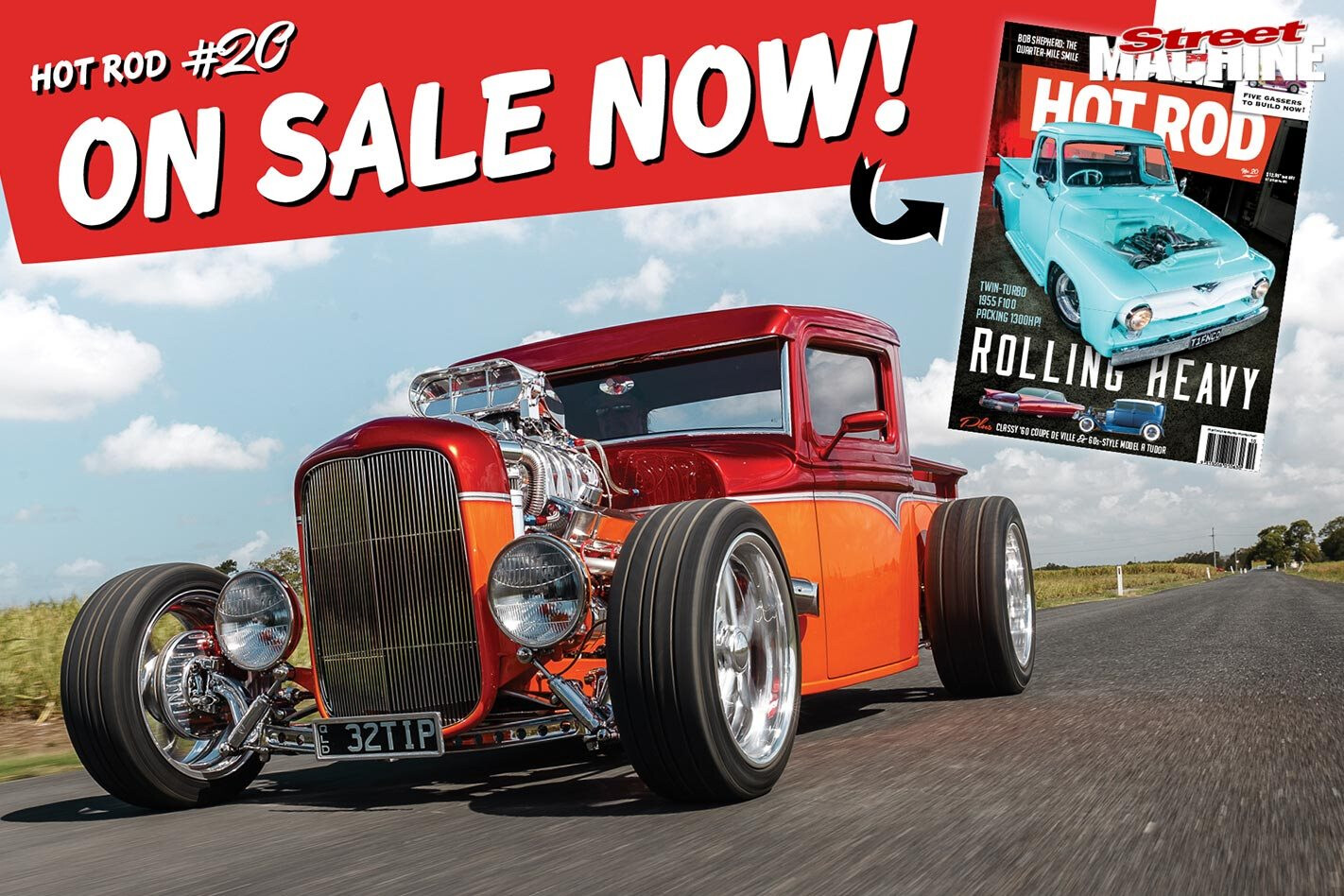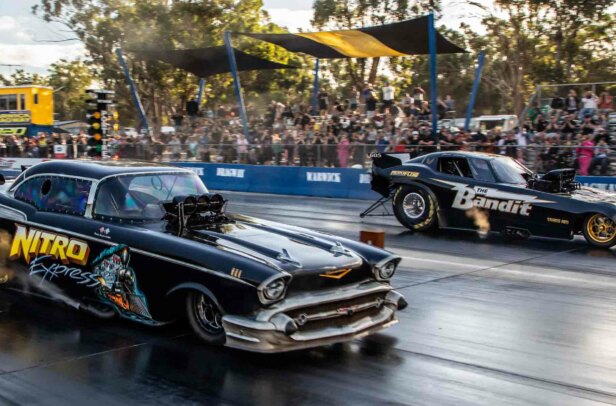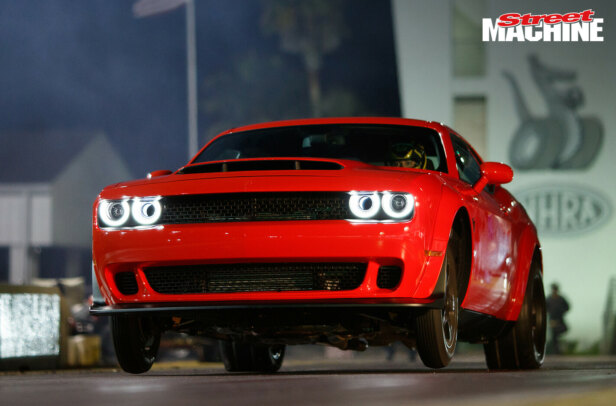DRAG racing is an unusual activity. At its heart it’s a blue-collar motorsport, but it creates opportunities for some people to become more than the sum of their parts, to rise above the world around them and forge a persona that carries them to a place they never dreamed possible.
This article was first published in Street Machine’s Hot Rod Magazine #20, 2019
Bob Shepherd – aka the Masked Hero, the Quarter-Mile Smile – is just such a character. But don’t let those light-hearted monikers fool you; Bob is nobody’s fool, and when he was on a race track he’d be giving his all to beat opponents into submission – even though he reckons he has the world record for the longest racing losing streak. But win or lose, he (almost always) was having a ball.
Bob and drag racing were made for each other, and with his long-serving crew (or Buccaneers as Bob calls them), he was a part of the quarter-mile scene for nearly 50 years.
“The first meeting I went to got me in,” he recalls. “Thinking about the thrill of staging a drag car, it’s raising the hairs on the back of my neck just talking about it. Unless you’ve done it, you can’t understand. It doesn’t matter whether you’re driving a 24-second car or a four-second car, there’s something about staging a drag car that you’ve got to do to understand that you’ve got to do it again.”
Bob drove this wheelstanding Thames van at the Castlereagh strip in the late 60s. It was built without knowing that there was even a rulebook
Bob’s racing career is divided into two halves. The first half began at the wheel of his street-driven EH sedan, before, as a member of the new Marigold Drag Team, he took the driving spot of a wheelstanding Thames van in 1967.
“The ‘Sinner’ Thames van had signwriting for Singer sewing machines; we called it Sinner because we only had to change the one letter,” Bob says. “We built it without knowing there was a rulebook. When we got it to the track we found that the engine was too far back and we couldn’t run in any class, so they called it a ‘funny car’. Then we discovered that if we put this big box full of steel on the back it would wheelstand.
Bob’s first serious crash was at Calder Park, where he was knocked unconscious. Bob remembers nothing of the incident, but it was serious enough for rescuers to have to cut the body off the car to get him out
“We were taking it to Calder and on the way the body fell apart because I’d only just learned to weld – it was all done with an arc welder – and the heavy box was on a trailer belonging to the Renfrew brothers, and that trailer fell apart and had to be left on the side of the road.”
In 1971 Bob ran a Holden six rail with a blower off a Commer truck.
Bob’s first outing in the ex-Graeme Cowin ‘Psycho III’ Fuel Altered was at Oran Park in December 1975, but he finished up in the concrete wall in the braking area
“I don’t know where we got the blower from, but it was used to pump oil or something and it was full of this black shit. We cleaned it up and it worked – when the belts stayed on. We put SU carbies on the top and I made my own manifold. For a blow-off plate I cut a hole in the manifold, welded two long bolts to the bottom and attached a 6mm flat plate with springs. Bingo! Instant blow-off plate!
“At the track, the engine backfired and broke the weld on one bolt. The next night, in the garage under the flats I was living in, I took the plate off and got ready to re-weld the bolt. I attached the earth and put the arc welding rod in the manifold. The explosion was like a small bomb as fuel fumes ignited. Luckily I had my welding mask on, because it blew me off the trailer and up the garage wall. Nothing caught fire, but my ego was bruised.”
Bob puts this incident, and countless others, down to a malady he calls ‘dickheaditis’. This is, according to Bob, a theme of his life.
“I’m not allowed to set the fire at home because I’ll burn the joint down,” he says. “I’m just very clumsy. I live on five acres, and I had to saw a branch off a big gum tree. It’s probably only two metres up, so I got a ladder, got my chainsaw, cut the branch off and it fell just the way it should, but the bushy bit on the end acted just like a trampoline and it bounced back up, hit the side of the ladder and took it and me out – dickheaditis!”
In 1975 Bob bought and campaigned Graeme Cowin’s ‘Psycho III’ Fuel Altered.
“It never blew up until I put a gearbox in the car,” he says. “Castlereagh track manager Dave Andrew said he didn’t want us pushing the car back after burnouts anymore, so we had to put a reverser in the car. While I was at it I put a Lenco gearbox in too, and in the garage I could reach everything but, of course, I never put my suit on, never strapped myself in, so when I took off in first gear and went for second gear I couldn’t reach it. By the time I realised, the engine blew up!
At the wheel of the ex-Graeme Cowin ‘Psycho III’ Fuel Altered. Bob loved the idea of crossed-up, out-of-shape burnouts to entertain the crowd, something he now laments has been lost to the sport
“When I first bought the Fuel car I put front wings on it, and on the first run one of them had kicked over and pushed the car off-line. Across the finish line I went for the parachute release and missed it, went for it again and missed again and had to go for it again. Once again, it had worked in the garage but not on the quarter-mile.
“So I went into the net, and that is the most frightening event you can imagine, because in a Fuel car the front goes under the net and the net stops, instantly, five centimetres off your nose because it’s the rollcage that stops it. If the rollbar came off, so would your head. That is the most frightening thing I have ever experienced.”
Bob had a fascination with twin-engined cars. This twin Holden six-powered car constantly broke the dual-chain drive link between the two engines. At one event he took the link out at and ran it in C/Dragster on just the back engine
In 1978 Bob’s Funny Car was engulfed in flames at Castlereagh – his first fire.
“I had been under my car at home doing the bearings when I was called to the phone. You should never do that. I came back and put the sump on, but I’d undone a cap and hadn’t done it back up. So when I got to three-quarter track it let go. The fire was so bad and I was getting so hot that I undid my belt and I jumped up on my haunches because I was getting out. I thought the car had gone into the bush on the right, so I bailed out the left window, but the car had gone in on the left and I’m running around covered in burning oil setting the bush on fire. The fire crew guy who got to me put the fire out and carried me out, getting burns all over his belly. They laid me on the ground and were peeling my firesuit off when Ken, my crewman, got there, and he thought they were peeling my skin off! It wasn’t widely reported, but I nearly burnt to death!”
At the end of 1978 Bob scored a drive in Ed Stipanovich’s ‘Sindicate’ Mustang nitro Funny Car. The car had great potential, but Bob had only limited success at the wheel.
“The problem we had was that nobody knew how to tune the clutch, so I’d be laying rubber and smoking the tyres all over the track,” he says.
Bob called time on the first phase of his drag racing career in 1979.
“It was just money that stopped us in 1979,” he says. “All those years that I raced, I’d worked nights pulling beers and my wife worked as a hairdresser, and every cent we ever had went into it. I had nothing, but we had a race car. We were well past the stage of thinking that maybe we ought to buy some furniture, or caring that we had an oven door that wouldn’t close properly.
“After we stopped racing the marriage fell apart too, so the marriage was all about what we did at Castlereagh, I think.”
Bob drove Ed Stipanovich’s ‘Sindicate’ Mustang in 1979, but was hamstrung by a lack of knowledge in the team on how to tune the clutch. Graeme Cowin had those skills and took over the driving
But Bob came back for big second act when drag racing returned to Sydney at Eastern Creek in 1990, piloting a series of Funny Cars, including a nitro-fuelled one that seriously injured and burnt him in a crash at Calder Park in 1998.
Bob bought this Barracuda alcohol Funny Car from Adelaide racer Kevin Christerson after a $10,000 win on the pokies, hence the name The Gambler. Bob was always a favourite with the crowds and had a never-ending string of T-shirts with current messages about his racing
“The fuel tank split off the startline and I hit the wall, knocking me unconscious,” he says. “The car continued down the track at about 70mph, burning badly, and came to a stop past the finish line when it veered across the strip into the other wall.
“I woke up in the helicopter on the way to hospital, and then again at hospital as they were cutting off my ex-John Force firesuit. I had a red, burnt, swollen face, no eyebrows and second-degree burns to my hands [the gloves had melted in the fire]. My brother, who lives in Melbourne, put me on a plane for home and told me: ‘Look down because if anybody sees your face you’ll frighten them.’ These are the consequence of an amateur – me – trying to race on nitro.”
Bob’s biggest moment came when he ran his first four-second quarter-mile pass, in February 2006.
“That was unbelievable and easy; that’s the silly part about it,” he says. “We’d run 5.0 maybe 30 times and it felt like another 5.0. I didn’t know I’d run a 4.97 until the fire crew told me. What got me was that the track and all the spectators there understood how important it was for us. The fact that they stopped the meeting to celebrate with us was amazing.”
In 2007 Bob surprised the drag racing world by offering his Top Fuel driving seat to his 19-year-old daughter Amanda.
“When she asked I said: ‘Look, you’re too young, you can’t reach the pedals, the answer is no.’ I can’t remember why I changed my mind. It nearly cost me my [second] marriage; my wife Lee and I split up for four months, she just couldn’t hack it. I thought it was a lot safer than she did, and obviously she was just worried about her daughter.
“I took Amanda to the Sydney track in a 15-second ute and took her up and down until she knew the place backwards. We took her to Ken Lowe’s driving school and she got her licence. Her first pass was a launch; that scared the crap out of her, but from that point on it was easy, which I don’t understand, because it’s not easy. Maybe it was her age.”
Bob jokes about losing streaks, but he has two gold Christmas tree trophies, this one while in ‘Masked Hero’ disguise for winning Competition Eliminator at the 1995 Winternationals
Bob’s last pass, in 2011 at Sydney Dragway, was also his quickest, running a 4.93 in qualifying at 295mph, but he hurt the car and didn’t have the parts to fix it properly.
“In the end we simply ran out of money,” he says. “In those days I had seven or eight guys working here and this factory paid for it, because you could do that then. They’ve changed the tax rules now where you can’t sponsor yourself, and my accountant said: ‘This has to stop.’”
If there’s been one unique facet to Bob’s racing career, it’s his capacity to finance race cars through all manner of sources, from wins on the pokies to hire car purchases.
“We bought the Cowin Fuel Altered with a car loan, and that’s what we did – bought a car,” he says. “I’ve always had a reputation of paying back whatever I borrow, so my credit rating with the banks was excellent. Those were the days when interest rates were sky-high, and if you didn’t meet the payments they’d come out and repossess it. I don’t know how they would have driven the Fuel Altered away!
“Kevin Christerson’s Funny Car was bought in 1992 out of, I think, nine dollars that I had in my pocket as we were being hustled out of a club at Penrith as it was closing. I put it through a machine and won $10,000,” he continues. “It was a one in hundred bazillion chance. I honestly believe that everything in your life is written in the book when you’re born, and it was written that on this day I’d win that money and tomorrow I’d borrow some more and buy a Funny Car, which is exactly what happened. I borrowed another $20,000-plus to get the car and spares.”
It’s been very important to Bob that his racing operation has been a family concern.
“To have a favourable impression on your family, it’s important that they admire you, if that’s the word,” he says. “They need to respect you, and drag racing gave me more respect with my children – Mathew, Rachel and Amanda – than anything else ever could. I think drag racing is important to every family that’s involved.”
At the end of the day, Bob has been such a widely liked and popular racer because of his philosophy: ‘If you can’t beat ’em, entertain ’em’.
“We’ve been in the entertainment business, because we weren’t really winners,” he says. “I think the whole deal is about entertaining the crowd. They’ve only got two people to watch; it’s not as though they’re having to track a whole crowd of you. I go to be there, to race. Winning is just a major, major bonus, because we never won many.
“I think I’d have a world record for the number of losses,” he laughs. “At one time I went from 1978 to 1995 between winning races [though they were both major events: the Grand Finals and the Winternationals], and with the Fuel car it was 10 years of never ever winning a meeting. Yet we were there, and smiling, and I’d do it all again tomorrow.”
The view from the crew
FOR Bob’s daughter Amanda, witnessing her dad’s first four-second pass in 2006 at Sydney Dragway will always be one of her most cherished memories.
“As soon as Dad hit the throttle, the golden flames reached high into the sky,” she recalls. “I got excited when the flames were still alight at half-track, and things were really good when the flames were still high at 1000ft, but when Dad went through the finish line and I looked at the timing board and saw 4.97, I honestly have never jumped as high as I did that night. I screamed with excitement, threw my fist in the air a thousand times and burst into tears.
“I remember running and jumping into the tow vehicle so fast and hard that I knocked my knee on the tow bar and almost didn’t make it into the back of the ute. The adrenalin stopped it from hurting instantly. The crew and I were hugging each other the entire way down to the bottom end. As soon as I reached Dad, I gave him the biggest hug I have ever given him and he hugged me back (this was a bonus considering he doesn’t like to be touched – he was on cloud nine).
“As we were driving back up the return road, the crew were all still going ballistic and Dad and I were hanging out of the Fuel car going crazy and celebrating along with the crowd. The track officials stopped us and did a massive interview with Dad in front of the crowd on the burnout pad – this made his night! To think that they all thought so much of my dad to stop the meeting and congratulate him on such a milestone was unbelievable.
“I’ve never been more proud of my dad than I was that night. He showed us all that we didn’t need the best of the best to hit this milestone – all we needed was perseverance, determination and a crew that would work hard and stick together like glue, and that’s exactly what we had!




Comments